|
Harv
|
 |
« Reply #220 on: September 02, 2014, 09:21:11 PM » |
0
|
3. The Bryant Special – an introduction to twin V8s.Eldred’s motor vehicle forays began at around the age of five at Port Noarlunga, a suburb in the city of Onkaparinga, South Australia. Having been left for a short period in a Stanley Steamer (similar to that shown in the image below), Eldred managed to crash the vehicle into a wall.  In (much) later years (sometime between 1936 and 1937) Eldred purchased the Bryant Special, shown in the image below. 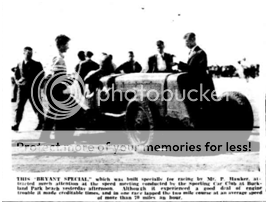 The car had been built by Max Bryant of Clare together with Peter Hawker in 1934, and was also known as the Bungaree Bastard (Bungaree was the name of the sheep station in the north of South Australia established in 1840 by Hawker’s grandfather George Charles Hawker). The Bryant Special had two Essex four cylinder engines coupled together, a format that probably influenced Eldred’s construction of the Double Eight in later years. The Essex engines in the Bryant Special were likely to either the 2371cc "L-head", though potentially also the earlier 2,930cc "F-head” (both engine types were rated at 55bhp). The engines are believed to have been sourced from Norman “Wizard” Smith, albeit in single format. Smith held records for travelling between major cities and was an incredible autosportsman. He also worked for Dalgety & Company, Sydney agents for Essex cars around 1920.
|
|
|
|
|
 Logged
Logged
|
|
|
|
|
Harv
|
 |
« Reply #221 on: September 02, 2014, 09:21:45 PM » |
0
|
In Bryant and Hawker’s hands the Bryant Special was driven at Sellick’s Beach (30 miles south of Adelaide) for the Sporting Car Club of South Australia’s Grand Opening Speed Meeting on Labour Day 1934. Bryant and Hawker also drove the vehicle at Buckland Park Beach (15 miles north of Adelaide). The Buckland Park Beach course was typically an oval lap, some two miles long with Hawker holding the lap record in late 1935. Hawker attempted to establish a national speed record in January 1935 in the Bryant Special at Buckland Park Beach (see image above right from the Advertiser of 29th January 1935), and held a novelty race against a Tiger Moth airplane (the plane lost due to headwind). The Bryant special was capable of 90mph on the sand, and could readily average 70mph over a two-mile course. With Casual Efficiency notes that on February 2nd 1935 Hawker attempted a national speed record at Sellick’s Beach, in the A class (unlimited). Being a flying start he crossed the start line at some 110mph, though a puff of blue smoke before the end of the course revealed that No.8 piston on one of the engines had failed. This effort was captured in Perth’s Sunday Times the following day. The Essex was also campaigned at the Sporting Car Club of South Australia’s first hillclimb at Newland’s Hill, Waitpinga in April 1935. Unfortunately, it broke a tailshaft and stripped second gear, reported by the press to demonstrate “it’s unsuitability for hill-climbing”.
By 1937 the Bryant Special was in Eldred’s hands. As reported in the Advertiser on the 8th of March 1937 under the banner “SPEED RACING AT BUCKLAND PARK”:
“Interesting motor cycle and motor car racing was presented by prominent speedmen at Port Gawler beach. Buckland Park, on Saturday afternoon. The non-appearance of E. Normans 'Bryant Special' robbed the car events of much interest. He had trouble with the car on the way to the beach.”
… and from the Advertiser on the 13th of April 1937 under the banner “SPEED METING AT BUCKLAND PARK”:
“Anzac Holiday Events
Entries for the Sporting Car Club events at the Anzac Day holiday (April 26) speed meeting arranged by the Southern Cross Motor Cycle Club at Buckland Park will close next Tuesday with the club secretary (Mr. G. L. Morris), or at the club's office in T. and G. Building. There will be two events, a six-mile handicap and a 20-mile handicap. Entrance fee for each race will be 2/6, and all competitors must hold A.A.A. licences. Minimum prizemoney will be: Six-mile, £1 and 10/; 20-mile. £2, 25/. and 15/. It is expected that the Miller car which was imported for the Grand Prix will be raced by its owner. Mr. Eric Morgan, and that the double-engined Essex car, previously owned by Mr. Peter Hawker, will be raced by Mr Eldred Norman. This car holds the fastest lap time ever registered at Buck- land Park. It averaged 71 m.p.h.. at the meeting conducted by the Sporting Car Club in January, 1935.
A post-meeting report from the Advertiser on the 27th of April indicates that tides cut the event short, and reports only results for motorcycle racing.
|
|
|
|
|
 Logged
Logged
|
|
|
|
|
Harv
|
 |
« Reply #222 on: September 02, 2014, 09:22:21 PM » |
0
|
4. The Double Eight – a twin V8 monster from Army surplusIn 1946 Eldred was purchasing ex-army vehicles left behind by the Americans for Bill Hayes and returning them to Adelaide. He partnered with Ron Mann, a friend from his university days to make two trips to the Australian Territory of Papua-New Guinea (PNG did not become an independent nation until 1975). A 7,000-ton ship was chartered to carry home the vehicles from the Port Moresby auctions. Tasked with getting six of the trucks between Darwin and Alice Springs at a time, Eldred connected them road-train fashion with timber poles and drove them himself without sleep. In hilly country the sixth truck was started, otherwise only the lead truck pulled. During one of the trips (which brought home fifty-five jeeps, around forty Blitz trucks and numerous generating and welding plant – see photo below) Eldred acquired a war-surplus Dodge weapons carrier chassis. This may have been the ½-ton VC series, or later WC series of military light trucks. 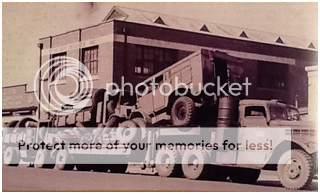 Eldred used the Dodge to construct a race car - the “Double Eight” (sometimes referred to as the Double V8, Bi-Mercury or Double Bunger). Eldred’s Double Eight, shown below with Eldred in the cockpit, was built from bodywork from aircraft and a tubular steel chassis with four-wheel independent suspension. The initial configuration, as shown in the image below, was a two-seater though the vehicle was to have several changes to bodywork over the years. 
|
|
|
|
|
 Logged
Logged
|
|
|
|
|
Harv
|
 |
« Reply #223 on: September 02, 2014, 09:22:54 PM » |
0
|
Power came from two Ford Mercury 239ci side valve flathead V8 engines for a total capacity of 7,800cc. These engines were good for 100-110bhp each when run independently, giving Eldred some 200bhp in the Double Eight. 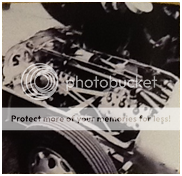 Whilst weighing in at a hefty 2500lb, the Double Eight had a power to weight ratio two and a half times greater than an FB/EK Holden. The Double Eight also had radiators, with one mounted up front and the other at the rear behind the driver. Despite the radiators, engine cooling suffered, with a tendency to overheat on long races. The engines were coupled flywheel-to-crank snout with a double-row Renold chain. The engines were timed to fire as a V16, with a Scintilla magneto providing spark. This large machine had water-cooled drum brakes supplied by four US-made Toronto fuel pumps. The drum brakes produced spectacular clouds of steam as Eldred applied them (the water activated by a switch on the brake pedal), despite being undersized for the task. The rear brake drums were built inboard, operating on the back axle and additionally cooled by a fan worked by the tail shaft. The Double Eight was fitted with truck wheels, which were later drilled out (presumably to lighten them). The wheels would come under some scrutiny at an Australian Grand Prix, as we will see below. Being South Australian road-registered, Eldred was frequently seen driving the Double Eight around the Adelaide hills… with trade number plates tied with string or a strap around his neck. During road testing of the Double Eight on the Port Wakefield Road beyond Gepps Cross a faulty steering pitman arm caused Eldred to pull into a service station. With the car up on the hoist it was evident that the spanner being used was a good fit. The spanner was welded into position and the car returned to service. Between 1948 and 1951 he drove the car successfully in hill-climbs and various race tracks in three States. The vehicle was also driven long distances to compete at tracks such as Fisherman's Bend, Victoria… a 900-mile roundtrip journey, sans mufflers. |
|
|
|
|
 Logged
Logged
|
|
|
|
|
Harv
|
 |
« Reply #224 on: September 02, 2014, 09:23:29 PM » |
0
|
The clipping below, from the News of the 19th of April 1949, shows the Double Eight at the Barossa Festival (Nuriootpa circuit, South Australia). 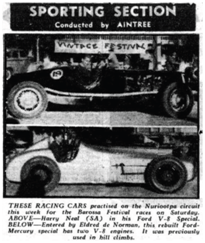 The clipping below is from the News of the 8th of October 1949. The meeting referred to at Woodside, South Australia was the scene of a tragic double fatality during motorcycle races. 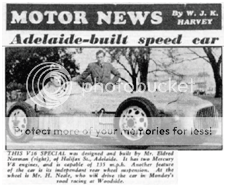 The Double Eight was also raced at Fisherman’s Bend later in October of that year. In addition to circuit racing, Eldred raced the Double Eight at Sellick’s Beach, South Australia where racing was undertaken between mile posts. An annual speed trial and motorcycle races were held on three kilometres or more of sand along Aldinga and Sellick’s Beaches up to 1953. The Double Eight won both the unlimited scratch race and over 1500cc handicap race held at the beach by the Racing Drivers Association of South Australia in April 1950. This event drew more than 5,000 spectators. One Sellick’s Beach incident involved Harry Neale at the wheel of the Double Eight. The incident started with a fire and ended with the Double Eight deposited into the sea, ripping off the bodywork and leaving Harry sitting on the chassis, wet but unhurt – see clipping below from the Broken Hill Barrier Miner of the 2nd of May 1950. 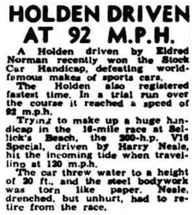 This is likely to be the same event as that depicted on the cover of Australian Motor Sports Magazine of June 1950 (see image below), which depicts Harry behind the wheel of the Double Eight at Sellick’s Beach. Harry (also known as the “Black Prince” as he drove in black trousers, pullover and helmet) was six-times Australian Speedway Champion, and sadly passed away at Claremont Speedway in 1959. 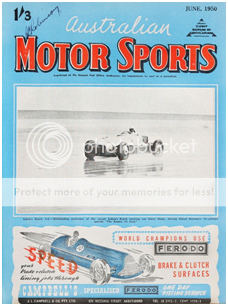 |
|
|
|
|
 Logged
Logged
|
|
|
|
|
Harv
|
 |
« Reply #225 on: September 02, 2014, 09:24:03 PM » |
0
|
Eldred’s can-do, larrikin spirit was also evident in the way he once retrieved the telephone cables laid out for communication between officials at each end of the Sellick’s Beach strip… by fitting a bare rim to the Double Eight rear axle and firing up the twin V8s to power what must have been Australia’s most powerful fishing reel. The Double Eight was also campaigned in hill climb service, and was entered in the South Australian Hill Climb Championship at Glen Ewin, Houghton in March 1950. On the day Eldred’s was the fastest car. The image below, taken From With Casual Efficiency, shows the Double Eight at this meeting (the image is labeled as 1948 in the text, though I believe that to be an error). 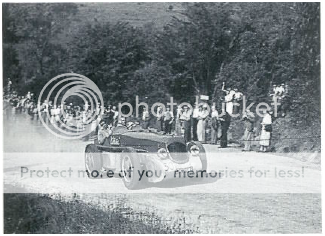 The Double Eight marked the start of Eldred’s entries into the Australian Grand Prix. The 34-lap January 1950 Australian Grand Prix was a Formula Libre motor race held at the three-mile square layout clockwise street circuit in Nuriootpa, shown below.  Formula Libre (or “Free Formula”) allows a wide variety of types, ages and makes of purpose-built racing cars to compete "head to head", with the only regulations often governing basics such as safety equipment. Eldred’s Double Eight was driven by Harry Neale, came 5th in the over 1500cc championship, though retired from the Grand Prix after only two laps. Bear in mind however that only thirteen of the field of twenty-nine vehicles actually finished. The image below shows the Double Eight at the 1950 Grand Prix.  Eldred entered the Double Eight in the Onkoparinga class handicap at the Woodside circuit in October 1950, coming second place by one minute despite having speeds of up to 120mph on the straight. The Double Eight was also entered (and took third place by 3.6 seconds slower than first place) in the Western Australian Hill Climb Championship at Mundaring in February. |
|
|
|
|
 Logged
Logged
|
|
|
|
|
Harv
|
 |
« Reply #226 on: September 02, 2014, 09:24:41 PM » |
0
|
The 1951 Australian Grand Prix was again run as a Formula Libre event in March at Narrogin, Western Australia. Getting the #10 Double Eight across to Perth proved to be a challenge. Eldred travelled with Steve Tillet, who was also entering his MGTC in the Grand Prix. The MGTC was loaded onto a truck, and a trailer fabricated to carry the heavy Double Eight. The trailer had eight pairs of small dual wheels. Whilst unused, the trailer tyres were old, with many being consumed during the journey. The truck turntable also failed, which Eldred welded up using locally sourced fencing wire. This repair was faster than one driver they passed who had been waiting three weeks for an axle to arrive. The 4.4-mile anticlockwise Narrogin circuit is shown below. 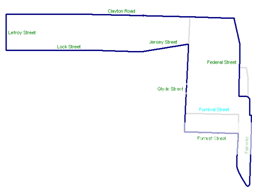 Eldred won one of the races early in the day before lining up for the main Grand Prix event. The bodywork of the Double Eight had been drastically changed prior to this race, turning it into a single seater and reducing weight. Additionally, holes had also been drilled in the truck wheels. The Double Eight is shown at this meeting in the two black and white images below, taken by Len Moore. 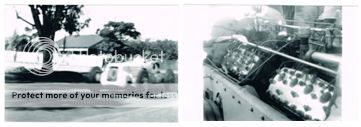 While leading on the seventh of twenty-four laps the Double Eight again broke down (this time due to suspension failure with the front axle locating rod coming adrift), leading to Eldred retiring from the race. Laurie Bug was Eldred’s mechanic, and travelled to Narrogin with Eldred for the event. Laurie saw the failure, and realized he had been working on the suspension prior to the race. Knowing Eldred’s volatile temperament, Laurie made himself scarce for the rest of the day. The photo below shows the #10 Double Eight at the meeting. 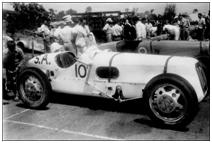 Steve Tillet (pictured in the image below) went on to win the Grand Prix on handicap, with his MGTC later purchased by Eldred’s son Bill (see below). 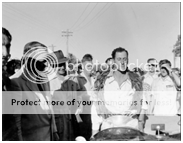 |
|
|
|
|
 Logged
Logged
|
|
|
|
|
Harv
|
 |
« Reply #227 on: September 02, 2014, 09:25:21 PM » |
0
|
The Double Eight was sold by Eldred later in 1951 to Syd Anderson. Anderson was proprietor of the Sydney Anderson Automotives used-car dealership in William Street, Perth and once Western Australia’s largest hire fleet owner with some thirty cars. During both Anderson’s and subsequent ownerships the car was modified repeatedly. According to legend, Anderson swiped a large mixing bowl from the kitchen, cutting it in half to make two air scoops for the Double Eight. Anderson raced the Double Eight extensively, including the following West Australian meetings: • The Great Southern Flying 50 meeting at Narrogin in March of 1952, winning the scratch race for over 1500cc (Eldred’s Maserati, see below, picked up the under 1500cc win), and coming eighth in the meeting main race (Eldred came second). Anderson can be seen in the #2 Double Eight in the photo below. The photo is labeled as Narrogin in 1952, though Eldred’s Maserati appears absent. The driver lineup, using Terry Walkers race results appears closer to Caversham in 1953. 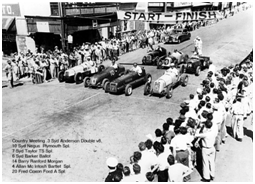 • The Northam Flying 50 meeting at Northam in April, winning the three-lap scratch race for over 1500cc. Anderson also competed in the five-lap handicap but did not land in the top three positions. He did however place fifth in meeting main race. • The Goomalling Speed Classic at Goomalling road circuit in June. Anderson placed the Double Eight fourth in the fifteen-lap handicap for Racing Cars, first in the three-lap scratch race for Racing Cars over 1500cc and first in the five-lap handicap race for Racing Cars. Anderson is shown driving the vehicle at the 2.4-mile anticlockwise circuit in the colour photograph below. The Goomalling circuit layout is shown below the photograph. 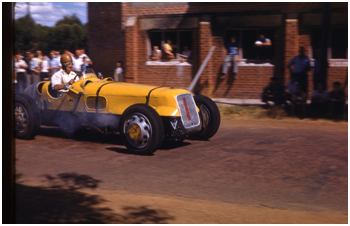  [/URL [/URL
• The Great Southern Fifty meeting at Narrogin in March of 1953, winning the three-lap scratch race for over 1500cc (Class A) and the Sports Car open handicap. In the race Anderson battled Sid Taylor in his TS Special and Sid Negus with his Plymouth. For several laps the drivers moved up the field but did not alter then positions with each other. Finally Anderson, the only driver off scratch, overtook Negus and almost headed Taylor. They finished together. It was in this lap that Anderson clocked 1 min 40 sec for the lap, an average of 80 mph for the circuit. The image below shows Anderson at this event, and receiving laurels at the meeting.
[URL=http://s929.photobucket.com/user/V8EKwagon/media/Andersonflattyre_zpsde08248d.png.html] 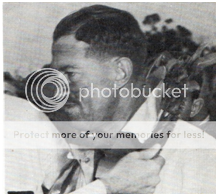 The images below show Anderson campaigning the Double Eight at this meeting (and on the same corner chasing an MG in the second image). 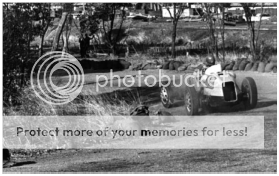 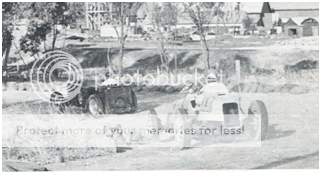 • The Caversham Speed Classic in December of that year, winning the three-lap scratch race for racing cars over 1500cc, placing second in the five-lap handicap for racing cars and third in the twelve lap handicapped main event for racing cars. |
|
|
|
|
 Logged
Logged
|
|
|
|
|
Harv
|
 |
« Reply #228 on: September 02, 2014, 09:25:58 PM » |
0
|
Anderson also competed in speed trials in the Double Eight. At Narrogin Airstrip in February 1954 he recorded the fasted time for the Standing Quarter for Racing Vehicles at sixteen seconds, and also for the flying quarter at 8.9 seconds. Anderson entered the Double Eight in the Johore Grand Prix in Malaya in 1953. The race was not held in 1954 due to concerns raised by the Johore Welfare Committee, a part of the state government, and would not be held again that decade. This was the first time that an overseas entrant and vehicle had entered the Johore Grand Prix. Anderson can be seen in the image below, together with Neil Moncrieff's 1100cc Cooper JAP twin (for the curious, JAP stands for JA Prestwich Industries, an English precision engineering company which produced engines from 1895-1963, often used in racing).  Unfortunately, Anderson had to retire from the race due to overheating. Freddy Pope (then president of the Singapore Motor Club) was the winner in the #22 Jaguar XK120S. In one incident during his ownership of the car Anderson was badly scalded when the radiator plumbing in the cockpit let go. At some stage between 1953 and 1955 Anderson ceased racing the Double Eight. The next person to campaign the Double Eight was Toby Carboni. Carboni was a seasoned racer, having competed in the 1954 Redex reliability trial in the #254 Ford Customline at the age of 20 (though Carboni travelled from Sydney through Townsville to Darwin then Perth, he did not finish). Carboni also raced stock cars in the 1950’s at Claremont Speedway, and owned the ex-Potter and Winters "Vandal" Top Fuel car (a 1963 Plymouth Super Stocker known locally as the “Ramcharger”). Carboni would later found Perth’s Carbon Brakes with Greg Nolan, along with five other successful businesses as diverse as a Cleenaway operation and a spaghetti factory. After racing in the Redex, Carboni was working for his brother’s truck repair business. He was tasked to take a six-wheel drive GMC truck to Syd Anderson’s business in William Street Perth to pick up a vehicle. Whilst finalizing the hook-up, Anderson appeared in a business suit, offered Carboni his business card and a job as a manager any time he wanted one. Carboni took the GMC back to his brother, returned on a motorcycle and took the job as foreman. Interestingly, Anderson had failed to mention to the old foreman that they had a new one… which became apparent when Carboni arrived for his first day of work! Not long after starting, Carboni noted that Anderson had the Double Eight tucked away in the rear of the yard under some sheet metal. After some discussion, Anderson told Carboni that provided he could get it going, he could use the Double Eight for races… as long as he didn’t beat Syd!. Carboni towed the car back to his home, and repaired it. He was then granted a permit to drive the car to work and back each day – all the way across the city of Perth! In the period of 1955-1957 Carboni raced the car extensively in Western Australia. The images below show Carboni in the Double Eight. 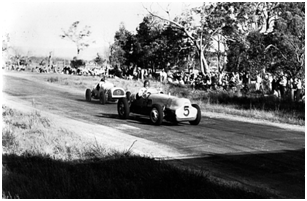 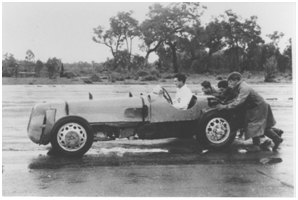 Carboni remembers racing against Anderson at one track, and waving to each other as they progressed. Anderson lost control, skidded off the course and crashed, with his helmet seen to go flying. Carboni approached, fearing the boss had been decapitated due to his waving. Anderson was non-plussed, telling Carboni to get the Double Eight ready for the next race – and he had better win it! He can also remember spinning the car off the track through gravel at Busselton, convincing the boss he was racing as fast as he could. |
|
|
|
|
 Logged
Logged
|
|
|
|
|
Harv
|
 |
« Reply #229 on: September 02, 2014, 09:26:44 PM » |
0
|
Carboni entered the Double Eight in the following events: • The Northam Flying 50 in August of 1955, placing sixth in the seven-lap racing car handicap (Anderson was racing an Austin Healey in that race and came fourth – luckily Carboni did not beat the boss). Carboni also entered the three-lap scratch race for racing cars over 1500cc though did not finish. • The Western Australian State Championships in September. In the first heat of Race 1 of the Racing Car Championship, Carboni placed fifth (Anderson’s Austin Healey coming in third). Returning for the second heat of Race 3, Carboni retired after seven laps (Anderson winning this race). • The Caversham Benefit Cup in October, placing fourth in the three-lap racing car scratch race. • The Spastic Welfare Cup at Caversham in November. Carboni entered the six-lap handicapped Race 2 though retired after two laps. He returned for the twenty-lap handicapped Spastic Welfare Cup for Racing Cars but again retired after ten laps. • The six-hour Le Mans Production Car Meeting at Caversham in May of 1956, placing second in the three-lap racing car scratch race and second outright in the fifteen lap Triangle Cup scratch race for Racing Cars (though not in the top four handicapped places). Carboni also raced in the main six-hour event in a Holden (with his brother Vince), placing fourth (he returned in an Austin Healey for 1959). • The 152-mile Australian Grand Prix at Caversham in March of 1957. Carboni entered the Double Eight in the class for Racing Cars, and was gridded between Syd Taylor in the 3.8L Plymouth Special and Syd Negus in the GMC-powered TS Special. Anderson noted the grid position, and mentioned to Carboni that he should be careful, as Taylor and Negus were his mates. Carboni queried Anderson – what do you mean mates? This is a race! Unfortunately, Taylor and Negus viewed that the wheels and tyres on the Double Eight were not appropriate to racing, and raised a protest with the circuit officials. The protest was supported, and Carboni was not allowed to start. By mid 1957 the racing game was changing, with cars coming under increased scrutiny. Being constantly under the microscope made racing the Double Eight difficult, and Carboni ceased campaigning the machine. The colour image below shows the car chasing Sid Taylor (in a TS Special) and Syd Negus (in a Plymouth) off the straight at Caversham, and is likely to be either the 1953 Caversham Speed Classic (Anderson at the wheel) or the 1955 Caversham Benefit Cup (Carboni at the wheel). 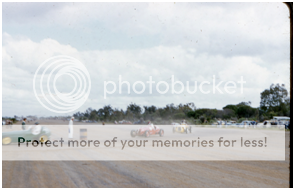 The Double Eight was then sold by Anderson to James Harwood, a navy veteran, musician and motor enthusiast in Perth. Harwood tossed a penny with Anderson to decide the purchase price - either £50 or £100. Harwood won. The vehicle was then towed to a business in which Harwood was a partner - Performance Cars at 173 James Street Perth where Bill Strickland (the renowned sports car and speedway speedcar/modified sedan driver) removed the two Ford V8 engines. The engines were later sold to a speedboat constructor. The Double Eight body was then placed outside Harwood’s business as advertising, though was removed a few days later at the request of Perth City Council. Keith Windsor bought the Double Eight body (probably in 1957) and installed a V12 Lincoln Zephyr engine, shown below. 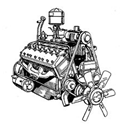 Lincoln produced these engines from 1936-1948, ceasing production nearly a decade before Windsor’s repowering of the Double Eight. I’m not certain if Windsor used the 267ci, 292ci or 306ci engine (110-130bhp), though in any case was a marked reduction from Eldred’s 478ci (~200bhp) twin V8 powerplant. The images below show Windsor and the #20 Double Eight in V12 format. 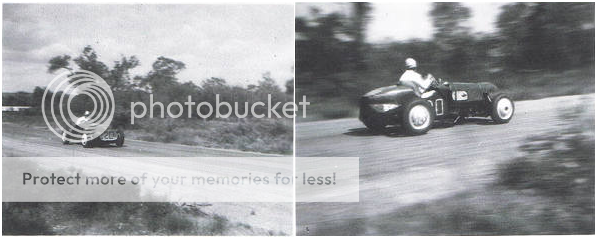 Windsor debuted the V12 Double Eight in the Christmas Cup at Caversham in late November 1958, competing in the five-lap racing car scratch race for over 1500cc, though did not place in the top three positions. Sadly, Windsor found the V12 vehicle was not manageable and subsequently scrapped it. The image below is of the Double Eight, though I am not sure of the period or location (the vehicle appears in single seater format, so probably 1950 or later).  |
|
|
|
|
 Logged
Logged
|
|
|
|
|
Harv
|
 |
« Reply #230 on: September 02, 2014, 09:27:24 PM » |
0
|
5. The Maserati 6CM – a gentleman’s car re-engined from scratch.After the Double Eight, Eldred then bought a 1936 Maserati Type 6CM. The vehicle is shown below during part of its later life in Europe, and has a layout similar to the line drawing. 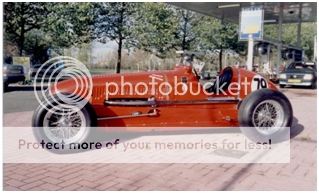 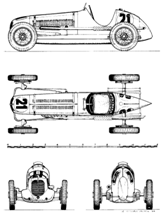 6CM stood for 6-cylinder monoposto (monoposto is a fancy Italian way of saying single-seat). The vehicle was fitted with a twin overhead cam 1493cc engine (shown below), with the GM Roots supercharger driven directly off the crank and being fed by a Weber 55AS1 carburettor. Eldred’s vehicle (chassis 1542), one of only twenty-seven built, had some 175bhp on tap… a power to weight ratio four times greater than an EK Holden. 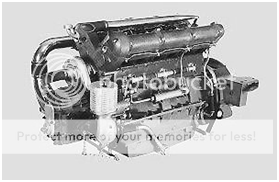 The Maserati had originally been delivered to Franco Cortese in April 1937. It then went to Scuderia Torino and to Ecurie Auto-Sport for de Graffenried and Balsa after World War II. It was later sold in the United Kingdom to Sam Gilbey (1947), then to Colin Murray (1949). Murray raced the vehicle in the Formula 1 class, including: • The April 1950 Goodwood circuit race, • The June British Empire Trophy at the Isle of Man circuit. He vied against a thirteen car field, though retired after nineteen of the thirty-six laps due to an accident, • The August Silverstone race. He again retired, for reasons unknown, from the field of nineteen (which included Juan Manuel Fangio and Stirling Moss). Murray brought the car to Australia in 1951, racing it in the March 1951 Australian Grand Prix. Like Eldred, Murray did not finish the race, completing nineteen of the twenty-four laps against a field of twenty-eight (remember that Eldred, in the Double Eight, completed only seven laps during this race). Murray (who is shown in the photograph below under the bonnet of the Maserati at the 1951 Australian Grand Prix) sold the Maserati to Eldred. 
|
|
|
|
|
 Logged
Logged
|
|
|
|
|
Harv
|
 |
« Reply #231 on: September 02, 2014, 09:28:07 PM » |
0
|
Eldred built from scratch a new engine block from steel blocks and welded sleeves with hard chromed spun-steel liners, cast two new magnesium bronze cylinder heads with hardened steel inserts and revised valve geometry, adapted connecting rods from a Singer 1500 (purchased by Jim Gullan in the UK and air freighted over), pistons from a BSA motorcycle and reconditioned the rest of the engine. Reading through what Eldred built from scratch shows an incredible engineering feat… and essentially a new engine (the Maserati crank was however salvaged). Eldred’s engine delivered 200bhp at 6,000rpm from the newly engineered engine, four and a half times higher power to weight than our EK Holden. Nancy was concerned with Eldred’s health during this feat of engineering, working long nights in the cold shed. She admonished him “For heavens sake, Eldred, bring it inside and work on it. You’ll die if you keep working out there every night!”. The next day Eldred removed the dining room window, lifted the engine inside by a crane and worked on it each night… on the large, French polished dining table given to them as a gift by a friend. As Nancy later recalled: “How could I complain. After all, I had burnt it (the table) with the iron!”. Eldred circuit-raced the Maserati in the 10½-mile race held at the Woodside closed-street circuit in October 1951. The course route is shown below. 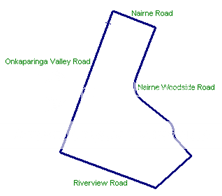 Some overnight welding work by Eldred saw a chipped second gear tooth replaced in the gearbox of Stan Jone’s Maybach I. Eldred finished the Woodside Jubilee for High Powered Cars race in third position, with his gearbox repair taking Jones’ Maybach to second place. After finishing the race Eldred stopped in the pits, raised his bonnet, and with a pair of pliers released two tins of pork and beans that had been wired to the exhaust manifold to cook. Eldred’s culinary skills were noted in Adelaide’s News The Odd Spot column. The vehicle was also planned to be raced at the Lobethal, South Australia street circuit in December of 1951, though South Australian cabinet came to the conclusion that “Highways or roads controlled by the Highway Commissioner will not be closed for such events”. Similarly to the Double Eight, the Maserati saw service in a variety of forms of motorsport. In December the Maserati was entered in the 460-yard Glen Ewen hillclimb at Houghton, South Australia recording the fastest time, breaking the previous hill climb circuit record and winning the meeting’s Unlimited class race. The vehicle was crashed in the March 1952 hillclimb at Collingrove, South Australia, stripping the gearbox in the process. This made for hard work in preparation for the Great Southern Flying 50 at Narrogin, Western Australia a week later. Eldred did however manage to get the Maserati back into working order and 1700 miles across to Western Australia. He achieved first place (and fastest lap at 2:27) in the under 1500cc scratch race, third place in the five-lap handicap race (posting both the fastest time and fastest lap at 2:20), and second place in the main handicapped Great Southern Flying 50 race event (again posting fastest time and fastest lap at 2:19). Remember from above that Anderson had also entered the Double Eight at this meeting – see the clippings below from the West Australian from the 14th and 22nd of March 1952. 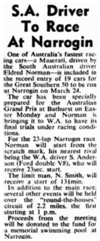  The Maserati also got a work-out in March 1952 for the public opening of the Collingrove Hill Climb track (see clipping below from the Sunday Mail of March 1952 and track layout). 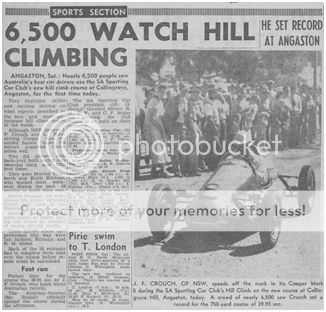 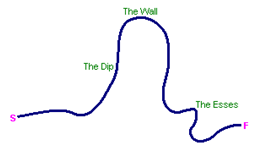 Eldred posted the fourth fastest time of the day (43.2 seconds), and won the category for Racing Cars over 1500cc and all supercharged. Nancy would also compete in this event, which was one by Judy Rackham in an MG TC. |
|
|
|
|
 Logged
Logged
|
|
|
|
|
Harv
|
 |
« Reply #232 on: September 02, 2014, 09:28:50 PM » |
0
|
The clipping below is from the News of the 21st of July 1952.  Whilst campaigning the Maserati, Eldred also drove other vehicles. In May of 1952 he won the South Australian Sporting Car Club's reliability night trial in a Holden. Only eleven of the twenty-two starters finished, with Eldred losing 580 points over the ninety-mile course, returning at 1am. In a normal trial of this kind, the winner would have lost 30-40 points and got home by about 10.30pm. Eldred raced the Maserati in the April 1952 Australian Grand Prix. This was again a Formula Libre motor race, held at the 3.8-mile anticlockwise Mount Panorama Circuit near Bathurst, in New South Wales. The course is shown below, along with a blurry image from the Advertiser of April 8th 1952, shows the Maserati prior to the race. 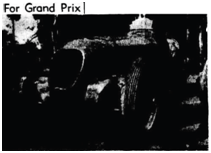  Eldred did not finish the race, completing ten of the thirty-eight laps due to engine troubles (the Maserati’s supercharger relief valve had come unscrewed). Eldred’s race-mate, Frank Kleinig, had to retire his Kleinig-Hudson 8 Special after only four laps. Kleinig’s name will be familiar to early-Holden fans as the man responsible for quite an array of grey motor speed equipment. Several articles indicate that Eldred’s ownership of the Maserati sowed the seeds of a lifelong contempt for small capacity engines with multiple camshafts, a view that is likely to make many early Holden enthusiasts smile. The noisy supercharged Maserati was never very fast, and had an insatiable appetite for pistons, including melting one out at Sellick’s Beach in October of 1952. The photo below shows Eldred (on the left) racing the Maserati on Sellick’s Beach (alongside Tom Hawke’s #5 Allard on the right) at this meeting, the first all-car beach program held in South Australia after the war. Tom Hawkes (who usually ran under the banner of 'Ecurie Corio') was from Geelong, with the Corio name coming from nearby Corio Bay. 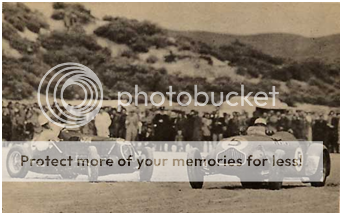 Bill Norman remembers being employed at age six to tightening the Maserati engine's many inaccessible nuts, one-sixth of a turn at a time. By 1953 the Maserati had been twin-supercharged, adding a second-hand Arnott supercharger to the existing GM Roots machine to deliver 285bhp,. The Arnott supercharger sat in the cockpit under the scuttle. The first supercharger remained crank driven, with the second supercharger duplex-chain driven off the first (that is one looong drive chain, running the length of the engine). 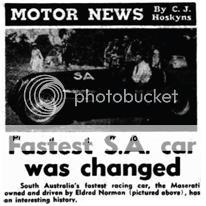 The car was being tested at the Collingrove hill-climb on Easter Monday. The vehicle would not run under 40mph, was good for 0-120mph in ten seconds, would stay at 120mph at half throttle, got 80mph in first gear and slurped methanol at one mile to the gallon. The power to weight ratio was now six and a half times greater than an EK Holden. The vehicle returned to Port Wakefield, South Australia for the Anzac Day race of April 1953, the Official Programme of which noted: “Eldred is never one to let the grass grow under his feet or the Maserati’s wheels”. |
|
|
|
|
 Logged
Logged
|
|
|
|
|
Harv
|
 |
« Reply #233 on: September 02, 2014, 09:29:26 PM » |
0
|
The clipping below is from Adelaide’s Advertiser of the 6th of October 1953, again linking the Maserati to Collingrove hill climbing. 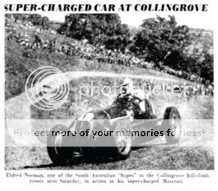 Eldred also raced at the Port Wakefield Tourist Trophy race that month, snapping the gear lever off the Maserati and finishing in third gear at 9,000rpm (the redline was 7,000rpm…) despite suffering badly from hay fever. A race report from one of the Gawler Airstrip meetings indicates that “Eldred Norman drove a steady race in the Maserati, stopping once to admonish two small boys who were too close to the track”. Alex Rowe was a close associate of Eldred Norman. Alex was significantly involved in South Australian speedway, building a number of supercharged engines. Alex was made an OAM on the 26th of January 1987 for service to speedway racing, an honour he shares with the likes of Bill Wigzell, Allan Grice, Craig Lowndes and Mark Skaife. In the mid 1950’s to early 1960s Alex Rowe had a workshop 9 Eliza Street St Peters, Adelaide. Alex later moved to what was called the St Peters Speed Shop in Payneham Road, St Peters and then to Winston Avenue. Rowe and his wife Helen later ran the Golden Fleece Service Station in about 1967/1968 at 87 Winston Ave, Melrose Park (now the current Winston Avenue Music Shop), and lived nearby at 130 Morgan Avenue. Rowe did a variety of work, including manufacturing and selling floor shifters for early Holden grey motor crashboxes. Part of the workshop would later be offered to Eldred to manufacture superchargers in the 1960’s (Eldred had his own workshop in Halifax Street). Eldred’s larrikin nature was well demonstrated one Friday night when he popped around to visit Rowe’s Eliza Street workshop in the early 1950’s... in the Maserati. The South Australian Police were looking for a race car seen coming up King William Street from the Halifax street region... funnily the car ‘vanished’ around Franklin Street! On arrival Eldred leapt from the vehicle and had time to light a cigarette before the Police pulled up. The Police ran in and asked whether a racing car had just driven in. “It went that way” said Eldred, after which they departed. This makes two Australian capital cities (Perth and Adelaide) to witness Eldred’s race machines trundling along, after Carboni’s daily commute in the Double Eight described above. Eldred sold the Maserati in October of 1953 to Ted McKinnon (a Melbourne motor dealer), who raced it in the 1953 Australian Grand Prix at Albert Park, Victoria (again in Formula Libre trim). Ted finished 15th out of the thirty-nine car field (Eldred did not enter the Australian Grand Prix in 1953). The vehicle then passed to Eddie Thomas in 1954, possibly for the Seaton brothers, who entered it for Ken Cox the same year. Cox later raced it with a Holden engine from 1957-1959, mainly on Victorian country tracks. The Maserati fell into disrepair, and was sold by Gavin Sandford-Morgan to Alf Blight in 1966. It was restored over many years until it raced at Mallala in 1982. Alf is shown at Amaroo Park in the 1980’s driving the #79 Maserati in the image below. 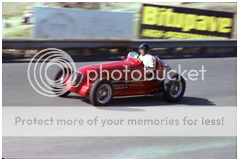 The Maserati passed to the United States, then to Robin Lodge (United Kingdom) in 1987, René Mauriès (France, who held it from 1988-1997, having been sold to him though Christies Monaco sales for $197,000), until sold at auction to Bernie Ecclestone in 1997. |
|
|
|
|
 Logged
Logged
|
|
|
|
|
Harv
|
 |
« Reply #234 on: September 02, 2014, 09:30:08 PM » |
0
|
6. The Singer SM 1500Eldred’s racing interests were diverse, as can be seen in the cuttings below from the Port Wakefield Grand Opening Speed Meeting programme of January 1953, and the 21st of October 1952. 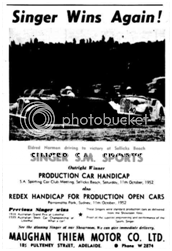 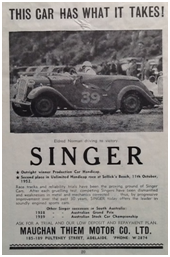 The advertisements (which both use the same photograph, just cropped differently) show Eldred winning the Production Car Handicap at Sellick’s Beach. The #39 vehicle Eldred is driving is a production Singer SM 1500 Sports, with a 48bhp 1497cc engine. The Production Car handicap referred to is Eldred's Sellick's win from October 1952. The 2nd place win ten days earlier is probably Eldred’s also. As an aside, it is interesting that there were three Singers in the 1938 Australian Grand Prix referred to in the advertisement, piloted by Seville, Pike and Beasley. All three retired from the race (an interesting way to advertise for new car sales). The 1939 Australian Stock Car Championship was Brady's win at Lobethal. In November of 1952 Eldred entered the Singer in the Collingrove hillclimb, recording a time of 51.5 seconds in front of the crowd of 4,000 people. As noted above, Eldred won the South Australian Sporting Car Club’s Kennedy Memorial Trophy that year for gaining the most points in all forms of competition. He went on to enter the Singer (as the #53 Maughan Thiem Motor Co Ltd vehicle) at the Port Wakefield Grand Opening Speed Meeting of January 1953 taking second place (he was also racing his #5 Maserati at the same event, also gaining second place). 7. The Triumph TR2 – a cross country driven Grand Prix machineAfter not competing in the Australian Grand Prix in 1953, Eldred returned in 1954. In the interim he had purchased South Australia’s first Triumph TR2 by Christmas 1953. The Triumph was registered SA 1435 and bought for £1,189 – see clipping below from Adelaide’s News of the 22nd of February 1954. 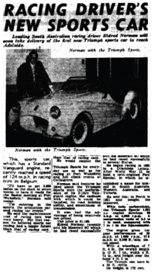 The original disc wheels were replaced with wire wheels, and an overdrive fitted (operated by a lever mounted beside the transmission tunnel). The vehicle had a completely standard white body and red interior, with a passenger tonneau, single aero screen and headlight tape... no roll bar or seatbelt. The Triumph utilized a Standard Vanguard engine, fitted with a 136ci/rev G.M. 2-71 supercharger, driven at 1.1:1 by four A-section belts and producing 12psi of boost. Eldred experimented with home-made fuel injection, eventually returning to a 2" SU carburettor. Engine internals were largely standard but the crankshaft was ground undersize, then built up with hard chrome. The Triumph was fitted with oil and water reservoirs, pressurized from the GM supercharger and controlled by a tap on the dash. The small 12½ imperial gallon fuel tank was replaced with a larger 30 gallon unit. Tyres were Adelaide-made Hardie cross plies, similar to those used later on the Zephyr Special.
|
|
|
|
|
 Logged
Logged
|
|
|
|
|
Harv
|
 |
« Reply #235 on: September 02, 2014, 09:30:47 PM » |
0
|
Mac Wilton was one of Eldred’s racing mechanics for a period in the 1950’s. Wilton arrived in Adelaide from England, and went job hunting the next day. After securing a job, Wilton walked down King William Street and was attracted by Eldred’s parked Triumph. Eldred wandered out and started talking to Wilton. Soon thereafter Wilton found himself employed as a racing mechanic, at less money than the job he had secured earlier in the day (ten shillings a week for endless hours). Wilton however viewed his time with Eldred as both fascinating and memorable, sharing many of Eldred’s highs and lows. Mac’s section of Eldred’s Halifax Street workshop became known as Dr Mac’s Surgery. In November 1954 Eldred and Dr Mac drove the Triumph 1300 miles to Southport, Queensland ready for the Australian Grand Prix. 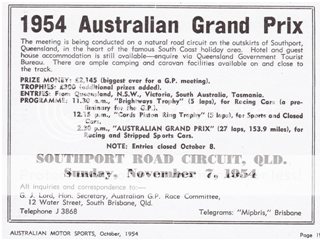 The Triumph was towing a trailer over mainly unpaved roads with two 44-gallon drums of methanol racing fuel. The 5.7-mile clockwise Southport circuit is shown below. 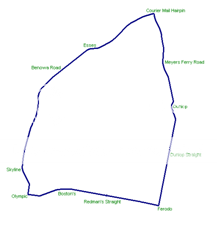 Winning the Brightways Trophy and Cords Piston Ring Trophy support races on the morning of the Australian Grand Prix gained him entry into the main race. Eldred removed the #8 Triumph’s engine decompression plate, gaining some power for the race in which he came fourth. By the end of the race the supercharger drive belts had stretched so much that boost had dropped from 12 to 8psi. One of Eldred’s race-mates, (later Sir) Jack Brabham, had to retire his Cooper T26 after only one lap, whilst the 4.3L Maybach Special II of Stan Jones broke in half at two chassis welds, depositing Stan in the scrub at 100mph. The images below show Eldred and the Triumph at the 1954 Australian Grand Prix.  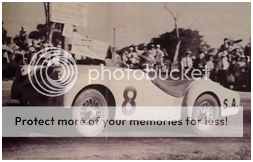 Eldred’s Triumph was driven from the Grand Prix track, and without any rebuild it then towed the trailer, trophies and two Longine watch prizes 1300 miles back to Adelaide, rattling gently from cracked pistons. The photo portfolio given to Eldred as a prize was later cut up by Nancy as it showed “Miss Cord Rings” by Eldred’s side. Whilst the Triumph is famous for its Grand Prix performance, it also received a considerable workout in other events, as can be seen by Eldred’s (aquatic) racing in the clipping below from Adelaide’s Chronicle of the 24th of June 1954. 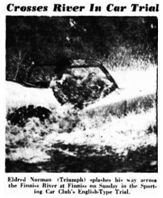 [/URL [/URL
The race shown is the mud-trial run by the South Australian Sporting Car Club, in which Eldred and Nancy took third place. The course included a creek crossing and hill at Brownhill Creek, a narrow hills track at Coromandel Valley, and the crossing of the Finniss River as shown to the right with a mud slope and sand course. Imagine doing that in a modern Grand Prix car, and afterwards racing in a Grand Prix.
The Triumph was also entered in the Collingrove hillclimb of April, and took first place in the 1,001-2000cc class at Port Wakefield in that month. In September the Triumph was raced at Fisherman’s Bend, Victoria then at the Port Wakefield races a day later. Eldred was to come fourth in the Churchill Motors scratch event at the latter meeting. The image below, from Adelaide’s Advertiser of the 8th of October 1954 shows Eldred preparing the Triumph.
[URL=http://s929.photobucket.com/user/V8EKwagon/media/thirtyseventh_zps282e27c7.png.html]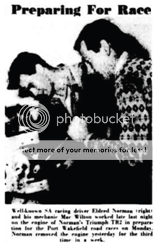 |
|
|
|
|
 Logged
Logged
|
|
|
|
|
Harv
|
 |
« Reply #236 on: September 02, 2014, 09:31:31 PM » |
0
|
In one incident in the Adelaide hills, Eldred noted that the Triumph’s tyres had all deflated. The cause was finally found – high loading under speed had forced open all the tyre valve stems. After Eldred’s campaigning, Eldred’s Triumph was raced briefly by his Eldred’s good friend Andy Brown then disappeared. The image below, taken from With Casual Efficiency, shows Brown in a supercharged Triumph TR2 in the fourth row of the starting grid of the third qualifying heat of the Australian Grand Prix at Port Wakefield in 1955. 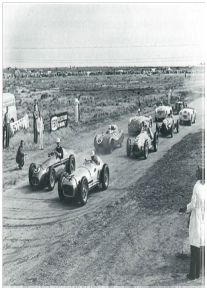 It is likely that this is Eldred’s vehicle. Brown was not successful in the qualifying rounds, and did not proceed to the main Grand Prix event. Eldred was racing his new project at this event, which we will see below. 8. The Zephyr Eclipse – incredible engineering.Eldred formed a relationship with an Adelaide Ford dealer, Eclipse Motors, and race a Zephyr sedan. The Zephyr sedan had a link to his next mission – a car for the 1955 Grand Prix. Eldred assembled a new car in ten weeks, only coming inside the house to eat and sleep in order to complete the new Zephyr Eclipse. As the design of Eldred’s Double Eight was likely influenced by his ownership of the Bryant Special, this new project is likely to have been influenced by the Clisby Special. The Clisby Special was built by Harold Clisby, and raced against Eldred in events like the Collingrove Hillclimb. The image below, taken from With Casual Efficiency, shows the Clisby Special at Collingrove in 1952. 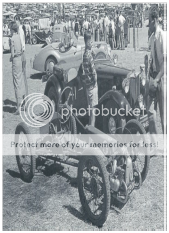 The vehicle utilizes a unique chassis/driveline technique (where no chassis is used other than a tube enclosing the driveline) which Eldred was to use in his new project. Clisby’s special utilisd a Douglas 350cc motorcycle engine, and with no body weighed only some 336lb, It had a power-to-weight ratio around 1½ times that of our EK Holden. |
|
|
|
|
 Logged
Logged
|
|
|
|
|
Harv
|
 |
« Reply #237 on: September 02, 2014, 09:32:09 PM » |
0
|
Eldred’s design was initially laid out in chalk on his workshop floor, with a heap of components from the wrecking yards supported on house bricks so that Eldred could get the wheelbase and seating position right - the driver of the Zephyr sits offset to the right. Like Clisby’s design, Eldred’s was unique in using no chassis – the front crossmember, engine and transaxle are all stressed chassis-members. The Zephyr engine was canted 45º to the right with a modified FJ Holden front crossmember. The crossmember is bolted to the timing cover, itself made from a hollowed-out piece of steel. A large diameter 6” tube bolted directly to the engine extending back to the rear-mounted clutch and transaxle, with the drive shaft running through the tube. The overall result is a wheelbase of 6’ 9.8” and a track of 3’ 11”. The humpy front end was fitted with unequal length wishbones, coil springs and telescopic shock absorbers. The rear end was fitted with a single upper transverse leaf spring, lower wishbone and telescopic shock absorbers, all bolted directly to the three-speed ZF transaxle, from a Tempo Matador truck. Double universal half-shafts provide drive. A Holden steering box is used. The body, fuel tank and seat are bolted to brackets welded to the tube, with the fuel tank immediately to the drivers left. The gearshift is high on the left side, almost chest height, with the shifter connected to a ball joint and an exposed square rod that runs along the top of the tube toward the rear. Girling drum brakes were taken from a 1.5 tonne Standard Vanguard, covered by 5”x13” wheels made from FJ Holden centres machined down to fit Zephyr hoops. Tyres were 6.4x13. The front wheels were originally drilled to lighten them and increase cooling, though this idea was later scrapped due to weakening of the wheels. The motor was originally a Ford Zephyr 2,262cc unit, supercharged at 1.5:1 with a Wade RO20 supercharger operating at 10psi. The supercharger is connected to the motor via rubber hoses and fed via a single 23/8” SU carburettor. The carburettor was rumoured to be either from Stan Jone’s Maybach Special Mark II, which crashed at the Australian Grand Prix in Southport, Queensland in 1954 (remember that Eldred campaigned the Triumph TR2 at this meeting), or from a Mayback military vehicle. The truth however is that the special methanol SU was specifically ordered from SU in England, and picked up by Alf Harvey from the SU factory before being delivered to Eldred (this story was shared by Alf to Graeme Snape). The SU is fitted with a second fuel bowl to prevent starvation. The fuel tank is pressurised (via a regulator) from the supercharger, though could be pumped up by hand by the driver for start-up. Visible through the hand-made wood and aluminium steering wheel were five gauges, with no tachometer (Eldred arguing that he valued a speedometer more). Recent photos shows this has increased to six. On completing the car, Eldred drove it to Adelaide (with trade plates) to have the body hand-built in aluminum. Bear in mind that during this journey the bodyless vehicle was running open exhaust headers, punching out some 116dB… sixteen times louder than average family sedan at 76dB, and similar to putting your ear 1m from a car horn. Nancy and Bill followed the new race car to Adelaide in the family Ford Zephyr convertible. The top bodywork section of the Zephyr was able to be lifted off for access, with the front grille showing a remarkable similarity to the Tempo Matador bonnet badge (see image below)… though of course with an “N” for Norman. 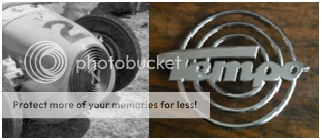 |
|
|
|
|
 Logged
Logged
|
|
|
|
|
Harv
|
 |
« Reply #238 on: September 02, 2014, 09:33:05 PM » |
0
|
The two-piece body is in light aluminum with an undertray suspended by brackets from the tube and the front cross-member. The bright yellow paintwork was completed with road-marking paint. The completed Zephyr weighed in at 1,527lb. The engine generates 280 to 300bhp (… a standard Zephyr is around 86bhp) – a power to weight ratio some 6½ times that or our standard EK Holden (… a bit higher than Clisby’s 1½ times). The Zephyr is good for 90mph in first, 130mph in second and on a long straight just under 160mph in top. Nancy’s recollection of the Zephyr was that it cost some £10,000 to build. On firing up and test driving the newly built Zephyr Eldred realized that his connection to the Tempo Matador ZF transaxle had delivered three reverse gears and one forward. Eldred is said to have laid into the work bench with a hammer for half an hour on realizing. On further test driving (along Halifax street) the sump was holed, a nasty thing to repair as the sump was difficult to remove. Eldred went down Halifax Street to Carrington Street, home of the Adelaide Milk Supply Co-Operative Limited (Amscol’s) Ice Cream works (pictured below) and returned with a bucket of dry ice. He filled the sump with the dry ice, allowing him to weld out the hole without distortion. 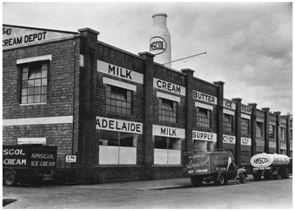 Eldred found that the low-volume Zephyr oil pump was not up to the task, and replaced it with an agricultural-type gear pump at the end of the camshaft sitting out over the front cross member. Hoses run to the wet sump, oil filter and back into the main oil gallery without the use of an oil cooler. John Cummins remembers watching Eldred in the Halifax street workshop shaping springs from flatbar. The intention was to make driveshafts for the Zephyr that would also act as suspension… one design feature that did not end up on the finished vehicle. The early name for the car was a bit of a mouthful - the Norholfordor - because it was built by NOrman from HOLden, FORd and Tempo MatadDOR parts. For the curious, a Tempo Matador was a VW-powered light commercial vehicle made from 1949 to 1954. It was then called the Eclipse Zephyr. The name Eclipse came from the Adelaide Ford dealer, Eclipse Motors who gave Eldred the Zephyr motor. The 80-lap October 1955 Australian Grand Prix was held at the Port Wakefield circuit, in South Australia. The 1.3-mile clockwise circuit is shown below. 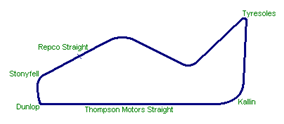 Refueling during the race was undertaken from a 44-gallon drum pressurized with nitrogen oxide to speed things up. Eldred and the Eclipse Special finished eighth out of a field of twenty-three. The race was won by (later Sir) Jack Brabham in a Cooper T40, six laps ahead of Eldred. The Zephyr Special was so unconventional that it was referred to as that "diabolical device". As Ray relates: “Scrutineers, too, found he had the answers. Concerned that the Eclipse Zephyr may not be strong enough, they obliged him to prove it was. “It’s strong enough o hold up a truck” Eldred boasted and was made to park it under a tabletop and jack up the tray body. Even so, many bets were laid about how many laps it would last before it broke in half!” |
|
|
|
|
 Logged
Logged
|
|
|
|
|
Harv
|
 |
« Reply #239 on: September 02, 2014, 09:33:49 PM » |
0
|
The photo below shows the #2 Eclipse Zephyr Special in 1955, taken in the pits at the Australian Grand Prix at Port Wakefield. 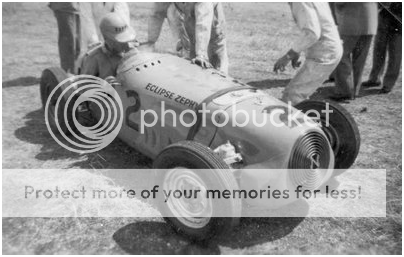 There is a fair chance that one of the gentlemen in the photo is his mechanic, Ramon Monkhouse. Ramon remembers that one of the teething problems with the Zephyr Special was that it was always tested on a straight road, and subsequently suffered from fuel starvation on corners. This was Eldred’s fifth, and sadly last Australian Grand Prix entry as driver, having entered in 1950 (DNF), 1951 (DNF), 1952 (DNF), 1954 (4th position) and 1955 (8th position). Whilst he did not collect too many trophies, Eldred did have his own trophy cabinet of melted pistons, broken valves and other mementos carefully arranged behind glass. The image below shows the Zephyr Special at Port Wakefield some time after the Grand Prix. 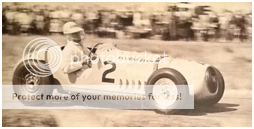 Like anything that Eldred built, the Zephyr has its share of anecdotes. After lunch on a particularly dusty day at the Port Wakefield circuit Eldred’s pit crew desperately tried to push start the Zephyr Special. With no success from the pushing, they then resorted to towing the Zephyr through the pits. Finally, with a few pops and bangs the zephyr fired up – spitting out flaming pieces of rag out of the exhaust. One of the helpers then admitted he had carefully tucked a piece of rag into the enormous SU carburettor before lunch to prevent the dust from getting into the engine. Whether the forgotten rag was passed through the supercharger, cylinder head and out the exhaust, or instead was blown out the inlet by a blower bang is debatable, though in either case must have been spectacular. Eldred’s practical (and somewhat agricultural) approach to engineering was also demonstrated in another discussion held with an enthusiast who had fitted a supercharger to a Morris Minor. To richen the mixture on the Morrie’s SU carburettor he had started to fiddle with the needle profile. This was done fairly exactingly by marking along the length of the needle at 1/8” increments and taking diameter measurements. The needles were then mounted in a lathe and the appropriate sections carefully machined down with some fine wet and dry abrasive paper to arrive at the “required” diameter. The enthusiast realized that Eldred’s recently completed Zephyr Special was also supercharged and fitted with a huge SU carburettor. Figuring that Eldred would have gone through a similar and probably more sophisticated exercise in matching a suitable mixture needle profile to suit the supercharged Zephyr, he approached Eldred. Eldred then proceeded to reach into his pocket and pull out an old tobacco tin, opened it up, and tipped out three or four of his “mixture needles”. The needles looked like 3” brass nails varying anywhere from hexagonal to triangular in section with very heavy filing marks along the length. On seeing our Morrie owner’s surprise Eldred commented that he needn’t be so fussy, as Eldred merely filed another flat on the SU needle about wherever he thought the mixture needed to be enriched. Eldred entered the car in the March 1956 Argus Trophy. This was a twentyfive mile support race for the Australian Grand Prix at Albert Park circuit, Victoria. However, he did not win the race. In late 1956 Eldred sold the Zephyr Special to Keith Rilstone, telling Keith "You will make this car perform" (which Keith did). The photo to the right is of Keith competing in the #2 Eclipse Zephyr at the Western Australia Racing Car Championship meeting in October 1961 at Caversham military airstrip in the Swan Valley (Keith retired from the race). 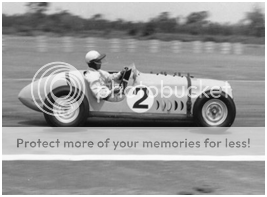 Caversham became Western Australia’s first dedicated motor racing circuit, and hosted the Australian Grand Prix in both 1957 and 1962. Military needs resulted in the Western Australia Sporting Car Club, the operators of the circuit, moving to their new home at Wanneroo in 1968. The photograph below is from Rilstone’s ownership, and were taken at Mallala Race Circuit South Australia. 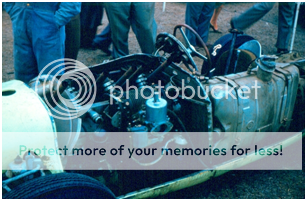 |
|
|
|
|
 Logged
Logged
|
|
|
|
|



